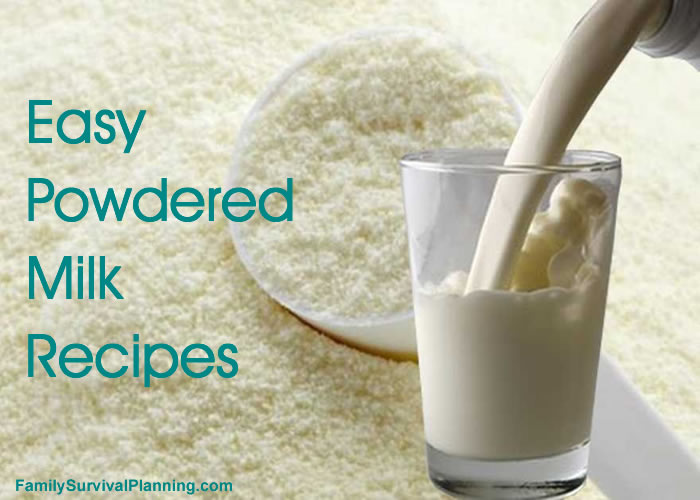- HOME
- Food Storage Recipes
- Powdered Milk
Delicious Recipes Using Your
Stored Powdered Milk

Few foods are as valuable as milk and milk products, which is why it is important to store powdered milk. Unless you have your own dairy cow, milk may be unavailable during an extended crisis.
Invest in emergency food storage now and enjoy peace of mind for the next 25 years. Don't miss out on the savings!
Buying the best quality dry powdered milk will provide the most nutrition as well as make the best dairy products. (I'll include some easy recipes in a minute.)
Low moisture powdered milk is important because this determines the shelf life of stored milk (about 4% is a good dryness). For best results in recipes and for longer storage, buy only non-instant dry milk.
Nutrition
Dry milk, whether whole or skim (non-fat), provides 9 essential nutrients: calcium, potassium, phosphorus, protein, vitamins A, D and B12, riboflavin and niacin (niacin equivalents).
Many people have allergic reactions to milk and milk products. The heating, pasteurizing, and drying processes destroy not only the bacteria, but also some of the essential enzymes (which is why we should store vitamin supplements also).
Like all food storage, powdered milk should be stored at temperatures of 60-70 degrees in sealed containers (cans or buckets with mylar bags) using oxygen absorbers or other vacuum sealing methods. (See Why and How to Store Powdered Milk)
Using Powdered Milk
Most dairy products can be made from powdered milk. We will cover how to use it for drinking (reconstituted milk), cottage cheese, yogurt, cream, and cream cheese.
Very few foods taste better, or are better for you, than freshly-made cottage or cream cheese. Hard cheese can be made with powdered milk but these kinds of cheeses are beyond this one article.
Reconstituted Milk
There are many brands of powdered skim milk on the market so the proportions of water and milk may vary. Don't be afraid to experiment and make it to your taste.
Makes 1 Quart
4 Cups cold water
1-2/3 Cups powdered milk
Makes 1 Cup
1 Cup of water
1/3 Cup of powdered milk
Beat ingredients with beater or mixer until smooth. To improve the flavor, mix it half-and-half with whole milk. Adding honey, powdered cream mixes, fruit juices, sugar, powdered sugar, vanilla flavoring, chocolate, or any other flavoring your family likes will improve the somewhat flat taste of the milk.
Mock Orange Julius
1 C. reconstituted milk
1/2 C. sugar or honey
6 oz. frozen orange juice concentrate
2 C. water
Ice
Put milk, sugar and orange juice in a blender; blend until mixed. Add water and ice, blending until mushy. Makes approximately 1 quart. May be thinned with additional water and ice, then sweetened to taste.
Soft Ice Cream
1 C. non-instant dry milk
3 C. water
3 Tablespoons honey
Mix in a blender, put in shallow tray and freeze until solid. To serve, break into small chunks and beat until soft. Serve with chocolate syrup, jams or jellies or other flavorings.
Yogurt
Yogurt is a very versatile food (and one of my most favorite dairy foods!). It can be a drink, mixed with fruit for a dessert, set in jello, and used in place of sour cream in stroganoff, sauces, chip dips, and fruit salads.
It's not hard to make yourself and the flavor can be varied from very mild to quite strong (tart) - and it's much cheaper than store bought.
Tips for Successful Yogurt Making
- In yogurt recipes, use plain or commercial yogurt for the starter or some left over from your last batch. You can also buy powdered yogurt cultures to start your batch. Most authorities recommend a fresh start every month or two.
- When using powdered milk, whether instant or non-instant, reconstitute it just a little short of being double in strength. Use two tablespoons yogurt starter for each three cups of double-reconstituted milk. Using this rule of thumb, make as much or as little yogurt wanted.
- The lower the temperature, the longer the yogurt takes to set. Temperatures between 110 and 120 degrees will produce firm yogurt in about three hours.
Yogurt Cream Cheese
This may be the simplest cream cheese method and the result is tangy and delicious.
Simply pour homemade yogurt into a cheese bag and let it drain for an hour or two. This drained yogurt can be used in recipes for dips, spreads, sauces and dressings. By draining of the excess water, a you will get a thicker consistency than that of ordinary yogurt.
Basic Cottage Cheese
Cottage cheese is made commercially from skim milk, reconstituted concentrated skim milk, or from non-fat dry milk solids. This recipe uses rennet or junket to help in producing low-acid cottage cheese.
1 gallon milk
1 rennet tablet (or 1/4 Junket tablet)
1 pint buttermilk or basic yogurt
- Dissolve rennet tablet in warm water.
- Pour milk into a large heavy pot and heat to 90 degrees.
- Add buttermilk or yogurt, stirring to mix.
- Add dissolved rennet.
- Cover pot and leave overnight in a warm place.
The next day you will find a gelatinous, almost solid mass-like firm yogurt in the pot. This is the urd. With a knife, cut through this curd to break it into small pieces. Now set the bowl with the curd into a pan of warm water and heat it up to 110 degrees. (A thermometer is essential in making any cheese product.) Shake the bowl gently while it is being heated to help distribute the heat more evenly.
When the curd temperature reaches 110 degrees, turn of the heat but leave the cheese bowl in the water for about half an hour. Then pour the cheese into a cloth bag or several layers of cheesecloth and hang it up to drain. Use a bowl to catch the whey if you wish to use it.
Later, when the curds have drained, mash the cheese with a fork, work in a little sweet or sour cream if you have used skim milk, or moisten it with a little yogurt if you do not want the extra fat in the cream.
Season any way you like with salt, caraway seeds, chopped chives, dill, parsley or other seasonings. If put into a blender, cottage cheese makes a delicious cream cheese.















